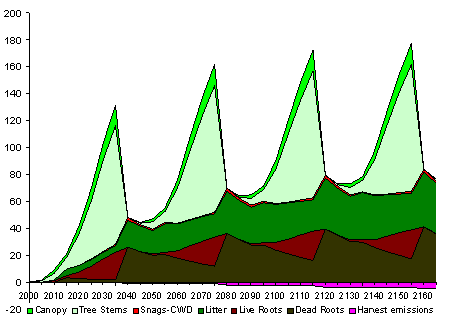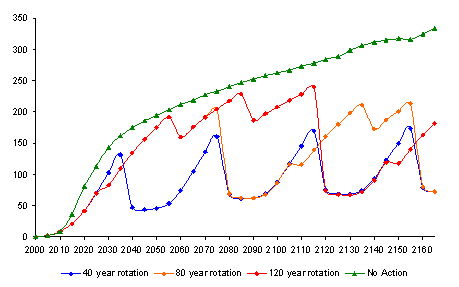|
The Impact of Forests and Forest Management on Carbon Storage
- a condensation of Manriquez 2002, and Bowyer
et al 2002 -
Bruce Lippke, John Perez Garcia, and Carolina
Manriquez 1
June 2003
Rural Technology Initiative, College of Forest
Resources
Box 352100 - rti@u.washington.edu
University of Washington
Seattle, Washington, 98195
**For the PDF version of this
thesis, click here.
Acknowledgement: This work was made possible
by supplemental funding provided by Columbia Pacific RC&EDD
and EPA. The modeling capabilities benefited by linking the findings
of the Consortium for Research on Renewable Industrial Materials
(www.CORRIM.org) with the Landscape
Management System, a landscape planning system developed at the
University of Washington (http://lms.cfr.washington.edu).
A more in depth development of the methodology including economic
considerations not covered here, are available in a Master's Thesis
by Carolina Manriquez titled: Carbon Sequestration in the Pacific
Northwest: a model, available in the library at the University
of Washington. Any opinions, findings, conclusions, or recommendations
expressed in this publication are those of the authors and do not
necessarily reflect the view of the funding agencies.
1 Lippke is professor and director
of the Rural Technology Initiative, Perez-Garcia is associate
professor and Manriquez is an MS graduate (2002), all in the College
of Forest Resources, University of Washington.
The Impact of Forests and Forest Management on Carbon
Storage
Introduction: Many studies have noted that older
forests generally store more carbon in the forest, hence reducing
carbon concentrations in the atmosphere. Some studies have noted
that the carbon pool in products is growing and is another important
source of stored carbon. Recent studies show that the carbon emissions
produced by the construction of steel or concrete buildings is considerably
greater than it is for wooden buildings. The Kyoto protocol treats
the flow of carbon from the forests into products as leakage, thereby
ignoring the impact of management that supports the flow of wood
into products, even though product storage is clearly increasing.
This study tracks the movement of carbon from forest to forest products
end uses, accounting for carbon storage and emissions at every stage
of processing through to ultimate disposal. The displacement of
carbon emissions from biomass energy conversion and substitution
of non-wood materials are important aspects of a complete accounting
system. A carbon tracking model is developed that forest managers
can use to determine the impact of their management plans on carbon
flows and storage pools. Reducing carbon emissions has become an
international commitment and carbon trading or credit markets are
developing. The objective of this project is to develop the full
carbon cycle and carbon account as impacted by forest management
decisions so that they can be supportive of constructive carbon
policies.
Developing carbon accounts for forests and their products:
The study develops carbon accounts for biomass carbon in the forest,
carbon in the processing of products, energy displaced from biomass
to energy conversion, and the displacement caused by the substitution
of non-wood products. Particular attention is directed at the impact
of alternative management scenarios including longer rotations,
more intensive management activities and no-management. The consequences
of changing the schedule of harvesting for products including a
no harvest option are shown to have a substantial impact through
the substitution of fossil fuel intensive non-wood products and
energy sources.
Carbon movement at the forest level:
In the development of a forest, above ground carbon in the stems,
canopy, and litter generally reaches a plateau but long after the
economic age for removing biomass for products. Stand conditions
impacted by management and other growing conditions determine the
carbon content and are modeled by using growth models that can be
calibrated to the species, growing conditions and treatment path.
Carbon in the fine and coarse root structures is also linked to
the growth model. The Landscape Management System (LMS) (McCarter
et al 1998) provided a useful software platform for controlling
growth models of the users choice so that each carbon pool can be
computed for a given sequence of treatments over time. LMS is initiated
with tree inventory or initial stocking data.
For the estimates of energy consumed in forest management, harvesting,
processing and construction, the findings of a several year research
project by a consortium of 14 research institutions across the US
(mostly universities) were used. The Consortium for Research on
Renewable Industrial Materials (CORRIM), a not-for-profit university
lead government research group, developed a research plan in 1998
to study the environmental performance of wood by developing a life
cycle inventory (LCI) data base of all inputs and outputs from forest
regeneration, through harvest, processing, construction, building
use and final disposal. Their interim report was presented at the
Forest Products Society 2002 annual meeting and is available at
(www.CORRIM.org).
Forests store carbon as they accumulate biomass until disturbances
or natural mortality more than offsets growth. Disturbances can
be natural (fire, windstorm, disease) resulting in decomposition
of the biomass (carbon emissions) or a management treatment resulting
in at least a partial flow of the biomass into product storage or
energy production thereby displacing fossil fuel sources. Figure
1 shows the several pools of carbon in a Pacific Northwest forest
under a near optimum economic rotation of 40 years.
|
|
| Figure 1. Forest carbon pools in metric
tons/ha for the 40-year scenario (after harvests in 2040, 80,
120, 160). |
In most carbon accounting budgets, forest harvesting
is usually considered to cause a net release of carbon to the atmosphere
(a decrease in the carbon storage pool) as is evident at the 40-year
harvest points in Figure 1.
Figure 2 shows the net forest carbon for different
management rotations. No-management is shown to store the most carbon
in the forest with the pool decreasing with shorter rotations.
|
|
| Figure 2. Net Carbon in the forest pools
for all rotations through time in metric tons /ha, with emissions
from operations deducted. |
Afforestation (conversion from non-timber uses) with
no harvest clearly produces an increase in carbon stored at least
until growth is offset by mortality. Longer rotations clearly store
more carbon in the forest than shorter rotations, roughly twice
as much by doubling the rotation. However, if products are removed
from the forest, the accounting is incomplete by drawing the boundary
at the edge of the forest as the exported product pools must be
accounted for before all carbon impacts can be determined.
Carbon movement at the products level:
Carbon pools from product processing were modeled by CORRIM based
on mill surveys
(Bowyer et al 2002). Roughly 50% of the biomass removed from the
forest is processed into structural products for construction (lumber
and plywood) with the remainder being co-products (wood chips, bark,
sawdust and hog fuel) used mainly in short term applications or
energy production. Short-lived products such as paper may enter
the waste stream quickly and decompose (estimated at 10% decomposition
per year). These co-product uses may involve additional processing
and energy use and are assumed to carry their own share of environmental
burden for those uses. Long-lived products such as those used in
housing construction do not decompose if properly maintained, although
there will be removals for social obsolescence reasons (estimated
at 1% per year). Over half of the 80 year old US housing stock is
still in use.
As more houses are built and the carbon stored in houses lasts
longer than the rotation age, the products carbon pool accumulates
from rotation to rotation. Figure 3 shows the products carbon pool
which is substantially impacted by rotation age with the shorter
(40yr) rotation age exceeding the products produced by the longer
(80yr) rotation until the first harvest of the 80yr rotation. Carbon
associated with the energy to produce the products is shown as a
negative.
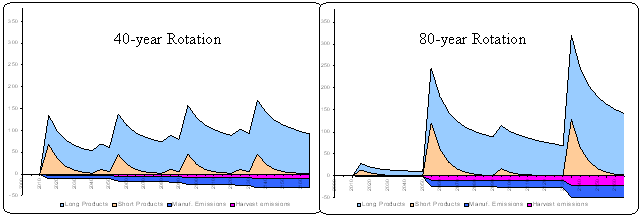 |
| Figure 3. Carbon sequestered in products
for 40- and 80-year rotations in metric tons per hectare. |
If the short lived products are used as a biomass
source for producing energy (co-generation), net electrical energy
is added to the electrical grid, displacing fossil fuels, thereby
providing another source of reduced emissions. While this biomass
conversion is not subject to the decomposition of short lived products
and therefore accumulates with every rotation, there is an energy
conversion loss of about 50% compared to the initial carbon in short
lived products as the efficiency of wood boilers is lower than natural
gas or other fossil fuel sources. Figure 4 shows the carbon stored
in the forest, in long lived products and the displacement of energy
when the short term products are converted to energy. It takes several
rotations for the biomass-to-energy conversion to significantly
increase net carbon storage.
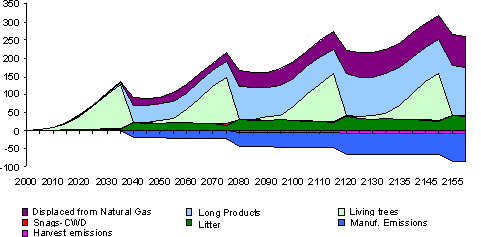 |
| Figure 4. Carbon sequestered in the forest,
products and energy displaced through time for the 40 year rotation
in metric tons/ha. |
Since the substitutes for short lived wood products
are likely to consume more energy than their wood based counterpart,
one should expect that the carbon stored in short lived products
would be greater than their energy conversion value.
Carbon displacement from substitute products:
As noted in the products pool, Figure 3, long rotations or no harvest
have a very negative initial impact on the product flow. Forests
taken out of production or with delayed harvests result in the substitution
of other products that are generally fossil fuel intensive like
steel and concrete to cover any loss in wood products. The apparent
benefits of long rotations on the carbon in the forest pool is more
than offset by losses from the energy consumed in substitute products,
Figure 5. The no-harvest option which produces no wood products
is the worst case, requiring the greatest use of substitute products.
While afforestation can increase the carbon stored in new forests,
not ever harvesting that new forest foregoes the opportunity of
increased product storage.
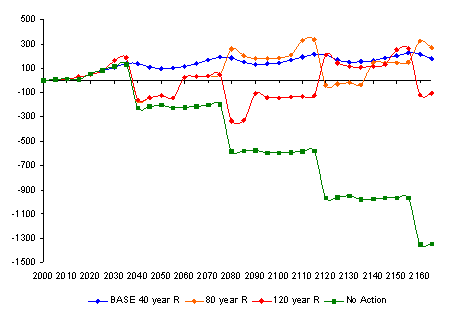 |
| Figure 5. Net carbon substitution
between steel and wood construction for all scenarios through
the 165- year management period against the Base 40-year rotation,
in metric tons/ ha of carbon sequestered showing affect of substitution
between steel and wood design construction. |
The case for intensive management:
While long rotations or no management (no products) requires substitute
products that increase carbon emissions for a long period of time,
more intensive management will generally increase wood product flows
earlier thereby increasing carbon storage. For a 40-year rotation
age, net carbon (all pools) increases from 56 metric tons per hectare
on average to 83 with more intensive management, a 48% increase.
Since the present value returns for these management scenarios are
almost equal, yet many owners are not intensively managing their
forest, presumably because of the increased effort and risk for
little economic gain, there is the opportunity to substantially
increase intensive management and carbon storage. Even small carbon
incentives (credits) could substantially increase management intensity
and carbon storage. An increase in intensity on half the private
forestland acres in Western Washington could trigger a 60 million
ton increase in carbon storage.
Summary of findings:
A carbon accounting system has been constructed for forest management
from the forest to end-use markets. The system can be used by land
managers to predict the impact of management treatments on carbon
flows and stocks. Carbon in the forest, in products, the impacts
of co-generation from biomass, and substitution among competing
product alternatives are all included in order to capture all changes
in flows. Contrary to the assumptions implicit in the Kyoto Protocol,
the results show that shorter rotation ages do not lead to greater
carbon emissions. They produce more products earlier than longer
rotations or no harvesting, adding to the growing pool of carbon
stored in products, largely in buildings. The so called leakage
of forest carbon into product streams is actually the most important
factor governing carbon storage derived from renewable wood products.
Forests managed more intensively increase the productivity of the
land base, producing more products and hence more carbon storage.
Incentives for managing the forest to increase carbon storage has
high potential, but only if all flows are recognized. It is the
carbon stored in wood products that provides the opportunity to
store more carbon and reduce emissions by using less fossil fuel
intensive products. The land management objective to increase carbon
sequestration should be to grow the most wood as soon as is economically
feasible. Carbon credit systems properly administered would induce
more intensive management of existing forests, and motivate sustained
forest management. Conversions of forestland to non-forest uses
would be reduced and could be offset by afforestation.
References:
- Bowyer, Jim, David Briggs, Bruce Lippke, John Perez-Garcia,
Jim Wilson. 2002. Life Cycle Environmental Performance of Renewable
Industrial Materials: CORRIM Phase I Interim Research Report.
CORRIM Inc. Box 352100, Seattle WA 98195. approx. 400pages
- Manriquez, Carolina. 2002. Carbon sequestration in the Pacific
Northwest: a model. Master's thesis. University of Washington,
Seattle, Washington, USA. 158 pages
- McCarter James, Jeremy Wilson, Patrick Baker, Jeffrey Moffett,
and Chadwick Oliver. 1998. Landscape Management through Integration
of Existing Tools and Emerging Technologies, Journal of Forestry,
Vol. 96, No.6, June 1998, pp17-23
Contacts: For more information visit the CORRIM website at
www.corrim.org or the RTI website
at www.ruraltech.org or contact Bruce Lippke, University of Washington
(206-543-8684) blippke u.washington.edu u.washington.edu
|







